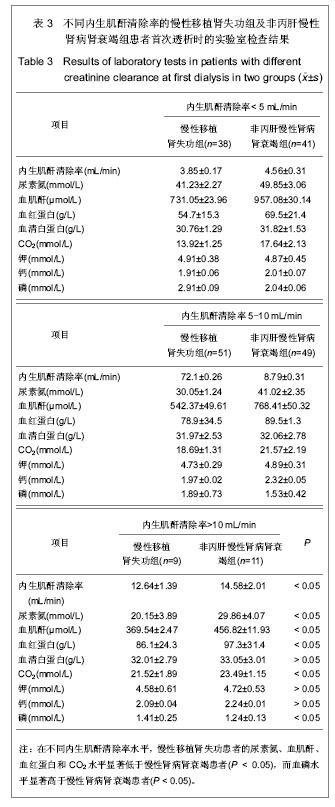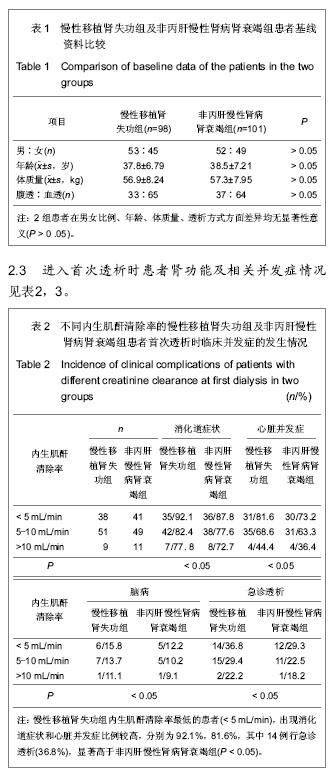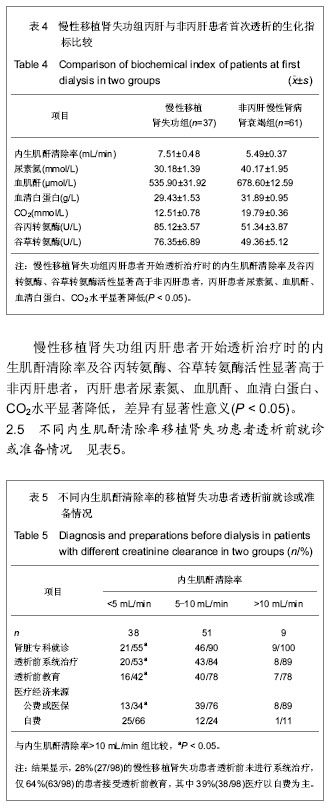Chinese Journal of Tissue Engineering Research ›› 2013, Vol. 17 ›› Issue (53): 9151-9156.doi: 10.3969/j.issn.2095-4344.2013.53.009
Previous Articles Next Articles
Dialysis time and influencing factor in chronic renal allograft dysfunction patients
Zuo Fu-jie1, Feng Xiao-fang1, Min Min1, Zhou Mei-sheng2, Wang Li-ming2
- 1Department of Kidney Transplant Rehabilitation, Central Hospital of Zhabei District in Shanghai (Changzheng Hospital Zhabei Branch), Shanghai 200070, China; 2Organ Transplantation Center, Changzheng Hospital, Second Military Medical University of PLA, Shanghai 200003, China
-
Revised:2013-09-05Online:2013-12-31Published:2013-12-31 -
Contact:Wang Li-ming, M.D., Chief physician, Professor, Organ Transplantation Center, Changzheng Hospital, Second Military Medical University of PLA, Shanghai 200003, China wt2530@yahoo.com.cn -
About author:左富姐,女,1983年生,安徽省安庆市人,汉族,2006年皖南医学院毕业,主治医师,主要从事肾移植术后康复方面的研究。 zuofj716824@163.com
CLC Number:
Cite this article
Zuo Fu-jie, Feng Xiao-fang, Min Min, Zhou Mei-sheng, Wang Li-ming. Dialysis time and influencing factor in chronic renal allograft dysfunction patients[J]. Chinese Journal of Tissue Engineering Research, 2013, 17(53): 9151-9156.
share this article

如表2所示,全部移植肾失功患者进入血液透析时的内生肌酐清除率为(5.94±0.63) mL/min,9例患者内生肌酐清除率>10 mL/min,51例患者内生肌酐清除率为5-10 mL/min,38例患者内生肌酐清除率<5 mL/min。内生肌酐清除率最低的组别(<5 mL/min),出现消化道症状和心脏并发症比例较高,分别为92.1%,81.6%,其中14例行急诊透析(36.8%),与非丙肝慢性肾病肾衰竭组比较差异有显著性意义(P < 0.05)。 如表3所示,进一步分析发现在不同内生肌酐清除率水平,慢性移植肾失功患者的尿素氮、血肌酐、磷、血红蛋白和CO2水平较慢性肾病肾衰竭患者显著降低 (P < 0.05),差异有显著性意义(P < 0.05)。 2.4 慢性移植肾失功组丙肝患者与非丙肝患者首次透析的生化指标比较 见表4。"

| [1] 王行予,常建英.移植肾失功后的血液透析患者发生肾反应并发症的临床观察[J].透析与人工器官,2000,11(4):3.[2] 陆石,吕振裕. 38例移植肾失功能后恢复血液透析的体会[J].临床泌尿外科杂志,1992,7(4):222-223.[3] 马潞林.慢性移植肾失功的原因和影响因素[J].中国血液净化, 2003,2(11):593,转617.[4] 王珏,张炜.慢性移植肾失功的危险因素及预测指标[J].国际泌尿系统杂志,2006,26(4):476-478.[5] 邹和群.移植肾失功分类诊断和治疗[J].器官移植内科学杂志, 2010,5(2):70-82.[6] 徐恩五,于立新,曾伟生,等.肾移植术后早期移植肾失功的危险因素分析[J].器官移植,2010,1(5):295-299.[7] 李晏强,罗皓,邹和群,等. MCP-1、RANTES在慢性移植肾失功肾组织中的表达及意义[J].浙江临床医学,2012,14(8):897-900.[8] 郭义峰.肾移植术后急性排斥反应的治疗和预防[J].中华临床医师杂志:电子版, 2013,7(1):10-11. [9] 徐卫波,张广伟,杜信毅,等.肾移植术后肾功能恢复延迟原因分析及预防[J].山东医药,2010,50(7): 98-99.[10] 万有贵,陈博,徐志强,等.肾移植后早期监测环孢素A血药浓度峰值的临床意义[J].中国组织工程研究与临床康复, 2011, 15(5): 843-846.[11] 裴向克,白玉梅.群体反应性抗体阳性对移植肾功能影响的临床研究[J].中国综合临床, 2013,29(4):399-402.[12] El-Shafey EM, EI-Nagar GF, Selim MF, et al. Is serum cystatin C an accurate endogenous marker of glomerular fiheration rate for detection of early renal impairment in patients with type 2 diabetes mellitus? Ren Fail. 2009;31(5):355-359.[13] 林开颜,张晋,蒙喻,等.人体表面积计算方法对内生肌酐清除率测定结果的影响[J].贵阳医学院学报,2012,37(4):397-398.[14] United States Renal Data System (USRDS). The USRDS Dialysis Morbidity and Mortality Study: Wave 2. Am J Kidney Dis. 1997;30: S67-85.[15] 殷苏燕.中药口服辅以灌肠治疗早中期慢性肾衰临床观察[J].中国民间疗法,2008,16(2): 34-35.[16] 农振勇.中西医结合治疗慢性肾功能衰竭40例临床观察[J].实用中西医结合临床,2011,11(3): 29-30.[17] Schulman G, Hakim RM. Improving outcomes in chronic hemodialysis patients: should dialysis be initiated earlier? Semin Dial. 1996;9:225-228.[18] 林家谊.维持性血液透析患者生活质量影响因素及健康教育研究进展[J].中华现代护理杂志,2012,18(16):1980-1981.[19] 王莉君,袁伟杰,谷立杰,等.终末期肾脏病维持性透析患者生活质量状态及α酮酸对其影响[J].中国血液净化, 2013, 12(3): 121-125.[20] 程宗华.维持性血液透析患者生活质量状况的调查[J].中国医疗前沿,2012,7(21):96.[21] Wu F, Cui L, Gao X,et al. Quality of Life in Peritoneal and Hemodialysis Patients in China. Ren Fail. 2013;35(4): 456-459.[22] 季大玺.浅谈透析时机对患者长期生存的影响[J].医学研究生学报, 2011,24(12): 1233-1235.[23] 殷俊,袁伟杰.终末期肾脏病患者透析时机的选择[J].中华肾脏病杂志,2012,28(7):575-578.[24] Rosansky S, Glassock RJ, Clark WF. Early start of dialysis:A critical review. Clin J Am Soc Nephrol. 2011;6:1222-1228.[25] 李红,高继宁,行延霞,等.老年慢性肾衰竭患者开始血液透析时机的观察[J].中华保健医学杂志, 2013,15(2):177-178.[26] Hemodialysis Adequacy 2006 Work Group. Clinical practice guidelines for hemodialysis adequacy,update 2006. Am J Kidney Dis. 2006;48 Suppl 1: S2- 90.[27] 王苏娅,陈江华,王逸民,等.乙、丙型肝炎病毒感染对肾移植患者长期存活的影响[J].中华器官移植杂志,2000,21(1):8-10.[28] 严春寅,王晖,陈卫国,等.丙型肝炎病毒感染对肾移植患者免疫功能的影响[J].中华器官移植杂志,2000,21(5):296-297.[29] 于立新,王志鹏,付绍杰,等.丙型肝炎病毒感染对肾移植术后影响的临床研究[J].第一军医大学学报,2004, 24(6):682-684.[30] 谢续标,蓝恭斌,彭龙开,等.乙肝/丙肝阳性供肾移植临床观察[J].中南大学学报:医学版, 2009,34(3):259-263.[31] 毕文浩,陈正,马俊杰,等.丙型肝炎病毒阳性受者肾移植后的安全13性分析[J].中国组织工程研究与临床康复, 2011, 15(31): 5789- 5792.[32] 兰天猋,任星峰,彭隽.乙、丙型肝炎病毒感染的肾移植受者肝损害临床观察[J].中国中西医结合肾病杂志, 2011, 12(9): 785-787, 后插3.[33] 陈小勇,李斌华,闫雪华.失代偿期丙肝肝硬化患者并发症消除后的抗病毒治疗[J].中华实验和临床病毒学杂志,2012,26(3): 229-231.[34] 黄英,杨颜茹.丙型肝炎后肝硬化与骨质疏松的临床研究[J].吉林医学,2012,33(23): 4938-4939. [35] 庄桂凤,张杰伟,曾仕平.肝源性糖尿病临床分析[J].中国医药, 2012,7(9):1105-1106. [36] Philpneri M, Bastani B. Kidney disease in patients with chronic hepatitis. Curr Gastroenterol Rep. 2001;3:79-83.[37] Daghestani L, Pomeroy C. Renal manifestations of hepatitis Cinfection. Am J Med. 1999;106:347-354. [38] Korevaar JC, Jansen MA, Dekker FW, et al. Evaluat ion of DOQI guidelines: early start of dialysis treatment is not associated with better healthrelated quality of life. National Kidney Foundation Dialysis Out come Quality Initiative. Am J Kidney Dis. 2002;39(1):108-115.[39] 陈灏珠.实用内科学[M].12版.北京:人民卫生出版社, 2006:2104.[40] 傅芳婷.把握慢性肾衰竭患者的透析时机[J].中国全科医学杂志, 2010,13(12):22. |
| [1] | Zhu Ning, Yang Xinming, Ruan Jianwei. Triptolide improves spinal cord injury recovery via upregulation of autophagy and inhibition of apoptosis in Thy-yfp transgenic mice [J]. Chinese Journal of Tissue Engineering Research, 2020, 24(在线): 1-. |
| [2] | Liao Yuan, Qu Mengjian, Liu Jing, Zhong Peirui Zeng Yahua, Wang Ting, Xiao Hao, Li Lan, Liu Danni, Yang Lu, Zhou Jun. Effects of ultrashort wave on inflammatory response in rats with acute lung injury [J]. Chinese Journal of Tissue Engineering Research, 2020, 24(在线): 2-. |
| [3] | Kong Desheng, He Jingjing, Feng Baofeng, Guo Ruiyun, Asiamah Ernest Amponsah, Lü Fei, Zhang Shuhan, Zhang Xiaolin, Ma Jun, Cui Huixian. Efficacy of mesenchymal stem cells in the spinal cord injury of large animal models: a meta-analysis [J]. Chinese Journal of Tissue Engineering Research, 2020, 24(在线): 3-. |
| [4] | Li Xiaoqun, Xu Kaihang, Ji Fang. Corylin inhibits osteoclastogenesis and attenuates postmenopausal osteoporosis in mice [J]. Chinese Journal of Tissue Engineering Research, 2020, 24(在线): 4-. |
| [5] | Zhang Shuang, Xu Xiaomei, Zeng Yang, Yuan Xiaoping, Lin Fuwei. Rev-erbα’s effect on osteoblastogenesis of mouse bone marrow mesenchymal stem cells [J]. Chinese Journal of Tissue Engineering Research, 2020, 24(31): 4921-4926. |
| [6] | Xun Chong, Wang Qiang, Li Changzhou, Liu Xiaofeng. Potential molecular targets and therapeutic mechanisms underlying transplantation of autologous bone marrow stem cells for the treatment of spinal cord injury based on bioinformatics [J]. Chinese Journal of Tissue Engineering Research, 2020, 24(31): 4927-4933. |
| [7] | Chen Jia, Yang Yiqiang, Hu Chen, Chen Qi, Zhao Tian, Yong Min, Ma Dongyang, Ren Liling. Fabrication of prevascularized osteogenic differentiated cell sheet based on human bone marrow mesenchymal stem cells and human umbilical vein endothelial cells [J]. Chinese Journal of Tissue Engineering Research, 2020, 24(31): 4934-4940. |
| [8] | Liao Jian, Huang Xiaolin, Zhou Qian, Huo Hua, Qi Yuhan, Wu Chao, Shi Qianhui, Yang Tongjing, Liao Yunmao, Liang Xing. Calcined bone/chitosan composite promotes osteogenic differentiation of bone marrow mesenchymal stem cells in Sprague-Dawley rats [J]. Chinese Journal of Tissue Engineering Research, 2020, 24(31): 4941-4947. |
| [9] | Wang Guoliang, Li Yanlin, Xiang Yaoyu, Jia Di, Li Canzhang, He Lu. MicroRNA expression profiles of chondrocytes in osteoarthritis induced by stromal cell derived factor 1 [J]. Chinese Journal of Tissue Engineering Research, 2020, 24(31): 4948-4953. |
| [10] | Li Yuanqi, Lin Hai, Luo Hongrong, Zhang Xingdong. Relationship between mitochondrial autophagy and chondrogenesis of bone marrow mesenchymal stem cells [J]. Chinese Journal of Tissue Engineering Research, 2020, 24(31): 4954-4960. |
| [11] | Liu Hao, Liu Jun, Rui Yongjun, Tang Fenglin, Lu Miao, Ding Tao. Co-transfection by Nell-1 and Noggin-shRNA promotes osteoblast differentiation of adipose derived mesenchymal stem cells [J]. Chinese Journal of Tissue Engineering Research, 2020, 24(31): 4966-4970. |
| [12] | Wei Renyue, Li Xuechun, Li Yan, Yu Yang, Zhang Yu, Liu Zhonghua. A serum-free monolayer method for differentiation of porcine induced pluripotent stem cells into vascular endothelial cells [J]. Chinese Journal of Tissue Engineering Research, 2020, 24(31): 4971-4978. |
| [13] | Gu Yubo, Zhang Dongliang, Yuan Wei, , Song Lujie. Exosomes from adipose-derived stem cells can promote cavernous nerve regeneration in rats [J]. Chinese Journal of Tissue Engineering Research, 2020, 24(31): 4979-4985. |
| [14] |
Zheng Haijun, Jin Hui, Cui Hongling, Zhu Yakun, Zeng Hui, Han Fengjie, Qiu Cuiting, Liu Jing.
Safety of drug-coated balloon versus drug-eluting stents in the treatment of type 2 diabetes mellitus complicated by coronary artery small vessel disease in older adult patients [J]. Chinese Journal of Tissue Engineering Research, 2020, 24(28): 4573-4579. |
| [15] |
Ma Chao, Wang Huishan, Han Jinsong, Yin Zongtao, Zhang Xiling.
Cardiac valve prosthesis implantation and surgical maze ablation for the treatment of valvular disease with atrial fibrillation [J]. Chinese Journal of Tissue Engineering Research, 2020, 24(28): 4580-4587. |
| Viewed | ||||||
|
Full text |
|
|||||
|
Abstract |
|
|||||





